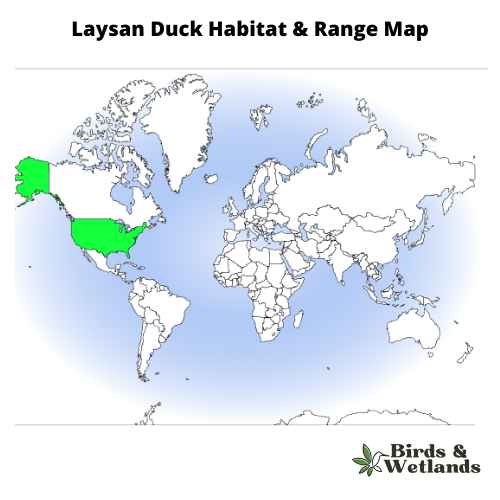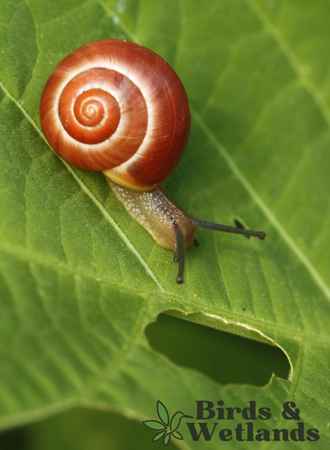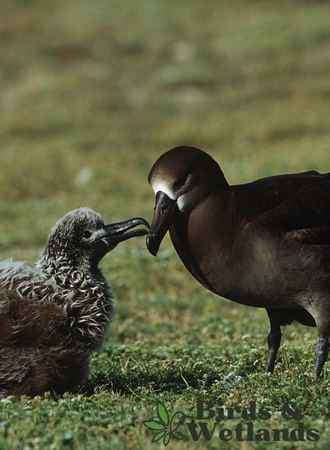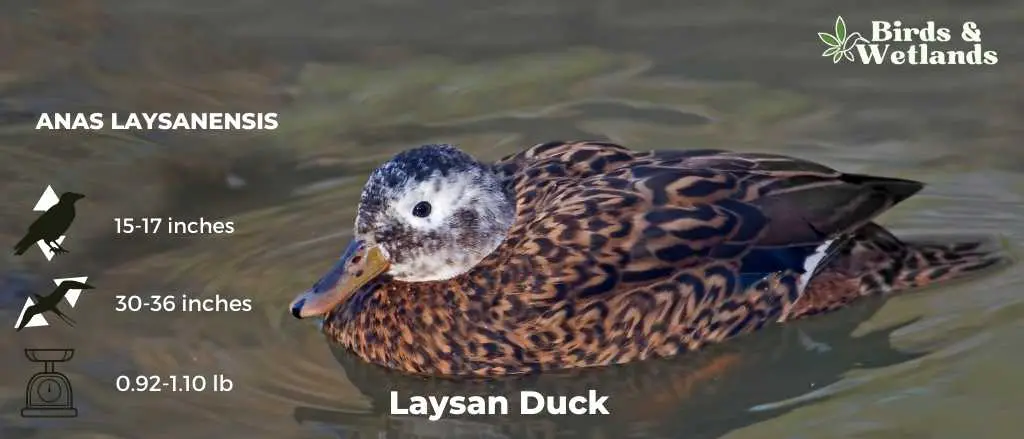The Laysan duck (Anas laysanesis), also known as the Laysan teal, is a small, endangered waterfowl native to the Hawaiian Islands. It is named after Laysan Island, the island where it was first discovered in 1892.
It is one of the rarest ducks in the northern hemisphere and has the smallest geographic range, too.
Due to habitat loss and predation by non-native species, the Laysan duck is listed as endangered by the US Fish and Wildlife Service. Efforts are currently underway to conserve and protect these ducks.
Scientific Name: Anas laysanensis
Height: 38.1 to 43.2 centimeters (15 to 17 inches)
Weight: 420 to 500 grams (14.8 to 17.6 ounces)
Physical Description
Males
The adult male Laysan duck is a beautiful waterfowl with unique plumage coloration. Its upper parts are mostly dull, dark chestnut to reddish-brown, while its underparts are a similar color but with a lighter grey tone. It also has darker brown subterminal spots on its feathers on both its upper and underparts. Extensive white feathering is common on the neck and head.
This species also has a prominent white eye ring around its eyes. Its beak has a dull green base color with dark markings along the upper half, and its eyes are dark brown. Its legs and feet are dull orange.

Females
The adult female Laysan duck resembles the male but has slightly darker brown upper parts. Her bill is brownish-yellow with a dark nail and culmen, and its wing speculum is brownish-gray.
Range
The Laysan Duck is primarily found on the small Laysan Island, which covers about 370 hectares. Its island homes are in a protective area.
In recent years, about 100 ducks have been translocated to two other islands, the Midway Atoll and Kure Atoll. This has expanded the Laysan Duck’s breeding range beyond Laysan Island and helped increase the species’ overall population.
Despite these efforts, the Laysan duck remains a threatened species due to its limited home range and the vulnerability of its habitat.
Fossil records indicate that these ducks once inhabit the main Hawaiian Islands of Maui, Kaua’i and the northwestern Hawaiian islands.

Habitat
The Laysan duck is a coastal duck that prefers to live in vegetated uplands, shallow wetlands and lagoons. These ducks inhabit various wetland habitats on Laysan Island, including ponds, marshes, and lakes. These wetlands provide the ducks with an abundance of food, such as algae, aquatic plants, and insects.
In addition to the wetlands, the Laysan Duck also uses the surrounding vegetated areas for nesting and resting. These dabbling ducks typically nest on the ground in dense vegetation, which protects them from avian predators and the elements.
Behavior & Diet
The Laysan duck feeds mainly in the evenings, at night, and during the early morning. Its diet consists primarily of brine flies. It also uses filter-feeding shrimps, insect larvae, snails, moths and other invertebrates. It also feeds on plant matter such as grass, sedge seeds, and algae from upland vegetation.
When hunting for flies, these ducks run through the swarms with their necks outstretched and their bills rapidly opening and closing, while keeping their bills close to the ground.

Nesting & Mating Habits
Couples form long-term pair bonds in the late fall, while mating and nest building usually beings in early spring.
During the breeding season, the female chooses the nest site and builds a well-concealed nest on the ground, under cover of dense vegetation. The nest is a shallow depression on the ground lined with dead grass and down feathers.
The female lays 4 to 6 eggs and incubates them for 28 to 32 days. The ducklings are precocious and can feed themselves 24 to 48 hours from hatching. Young birds gain their flight feathers at around 60 days from hatching.
Males molt with other males during the incubation period. Females molt soon after brood rearing.

Near Extinction & Recovery
The decline and near extinction of the Laysan duck can be attributed to several factors, including habitat loss and predation by non-native species.
Human activities such as development and agriculture have severely reduced the Laysan duck’s habitat. In addition, the introduction of non-native mammalian predators, such as rabbits, cats and rats, has devastated the Laysan ducks. These predators are not native to Hawaii and have no natural predators on the islands.
For instance, guano miners introduced European rabbits to the Hawaiian islands in the late 19th century, resulting in the decline of this duck’s population and the island’s vegetation. The population grew since then but hasn’t quite bounced back yet.
As a result, they have been able to reproduce rapidly and spread across the islands, preying on the Laysan duck. This has put significant pressure on the Laysan duck population size, leading to a decline in numbers.
Threats & Conservation
Currently, the Laysan duck is protected under the Endangered Species Preservation Act, and efforts are underway to conserve and protect the species and its habitat. It has been on the U.S Endangered Species list since 1967.
The U.S. Fish and Wildlife Service has established a draft revised recovery plan for the Laysan Duck, which includes measures to control introduced predators, such as rats and cats, and to protect and restore the duck’s breeding and feeding habitats.
In addition to these conservation efforts, these birds are also the focus of ongoing research and monitoring by organizations such as the U.S. Geological Survey and the Pacific Island Ecosystems Research Center. These organizations are working to understand the biology and ecology of these birds to inform effective conservation strategies.
Despite these efforts, Laysan ducks remain a critically endangered species, and continued conservation action is needed to ensure its long-term survival. Climate change which results in sea level rise, avian botulism, increased frequency of storms and environmental catastrophes such as oil spills, remain threats to these ducks.

Hunting
Waterfowl hunting is prohibited in Hawaii for several reasons. One of the main reasons is that Hawaii is home to several unique and endangered species of waterfowl, including the Laysan ducks and Hawaiian geese.
These species are found nowhere else in the world and are protected by state and federal laws. Hunting these species could have a devastating impact on their populations and could even drive them to extinction.
By prohibiting hunting, Hawaii can ensure that these species can thrive and continue to be a vital part of the state’s ecosystem.
Key Points
- Laysan ducks are an endangered duck species endemic to Laysan Island. They were previously found throughout the Hawaiian archipelago.
- Among its favorite foods are adult brine flies and moth larvae. These ducks also filter feed seeds and small animals.
- Wetlands and hypersaline lakes provide important foraging habitat for these ducks.
- Nesting occurs after the female builds the nest.


